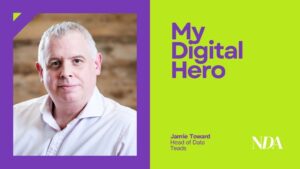Cadi Jones is one of the most respected leaders in the programmatic industry and is NDA’s new monthly columnist. Jones joined research tech business Qmee as Chief Commercial Officer in April to help it expand-zero party data services for publishers. She was previous at Beeswax, preceded by stints at Clear Channel International and Yahoo.
In 2015, opening an address to the annual Economic conference, Angela Merkel, then Chancellor of Germany said, “Everything that can be digitized will be digitized.” While Angela Merkel may not be the first person to come to mind when you think about digital transformation, it would be a struggle for anyone in the field of marketing, communications or measurement to dispute her comment.
In recent years, the most impactful changes to the media world have been in the digital transformation of media execution, as programmatic has become the primary transaction method, as well as the digital transformation of more media channels – with audio and Out of Home showing significant growth as a result of this move.
I’ve recently moved away from programmatic advertising and into a new world of programmatic: programmatic market research, from #AdTech to #ResTech and wanted to share my perspective on what I’ve learnt from the move to programmatic across a few different channels!
Why does programmatic / digital transformation drive growth?
From my personal experience, digital transformation drives growth in a number of ways that make for a very rewarding career. Firstly, the more you can automate, the less time the people in the team need to spend on basic, labour-intensive repetitive tasks. For example, earlier in my career, working at Yahoo, all optimization across both Search and Programmatic campaigns was done manually – in programmatic terms, that meant manually creating a new line item for each targeting technique proven to be effective, to route more spend to the more effective techniques and less to the less effective areas.
With every line that had to be manually created, there was scope for human error to creep in – to add the wrong creative, or the right creative with the wrong tracking code, to add or remove a zero from the budget.
As programmatic advertising became more widely adopted, advances were made so that this process could be carried out in a more automated way. And as it has grown further still, many platforms now offer optimisation recommendations, so that opportunities for performance improvement are not missed. This not only reduces the risk of human error, but also leads to better performance more quickly.
Effectively, machines are generally better at spotting patterns more quickly and more reliable in taking on repetitive and [simple] tasks such as trafficking creatives. But this is where it gets rewarding for us humans: as the machines pick up the repetitive, low value tasks, it frees us up to focus on the areas where we can add most value, in thinking about opportunities that may not have been spotted by the machines.
Machines are also much more able to take into account many more variable factors and in near real time, so can build much more complex models and keep track of their performance more reliably. This last one is very much true across ResTech.
From #AdTech to #ResTech
Just as in digital advertising, where before programmatic an advertiser or their agency would have to contact multiple publishers in order to buy media at scale to reach a wide audience, going back a few years market research was restricted by the size of the market research agency’s panel. Maintaining the panel of enough respondents covering a wide enough swathe of the general population to be representative of a brand’s target audience was incredibly difficult. To extend the reach of a panel was very manual, and consequently very slow.
The big change to Market Research has been driven by digital transformation. As internet and device penetration has grown to cover all segments of the population, market research has been able to access the general population through digital tools.
The majority of market research surveys are now carried out digitally and a significant portion of these on a mobile phone. Consumers are right now completing surveys whenever and wherever they want to, meaning a brand can conceivably request that their surveys run at times of day when their target audience are commuting to work, or thinking about what they might eat for lunch.
The big challenge for traditional brands, and particular those sold via other retailers, has always been how to get feedback from a wide enough pool of users, quickly. It’s one of the reasons that direct to consumer (DTC) brands have been able to gain market share in so many sectors: DTC brands had access to direct and clear feedback from their customers and prospective customers, so they could adjust all of their key variables, their product, their offerings and their advertising in near real time. Traditional bricks and mortar brands were at a real disadvantage, having to wait for slow feedback from more traditional sources.
So as market research has moved programmatically, a market research agency can release their survey onto an exchange, where Research Technology entities such as Qmee, can enable their users to complete the survey, and the market research agency can get meaningful scale of responses very quickly.
In this way, automation and the move to programmatic is again removing the need for a large part of the manual work, so that market research agencies can focus on the creation of meaningful surveys that will enable the brands they work with to better understand their target audiences’ needs. Users who are open to taking surveys can find a wide variety of surveys to take, and can be quickly matched to the right survey by their trusted platforms. And there is much less room for human error to creep in!
I’d like to finish with another quote, from another inspirational woman, Marisa Mayer. Speaking about programmatic advertising, again in 2015, she said “the opposite of programmatic is manual, not premium”. It’s funny that this seems to be something that we need to be constantly reminded, as programmatic crosses into new parts of the marketing and communications industry, and beyond.











